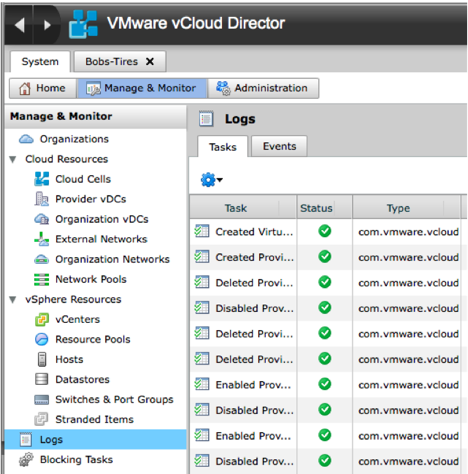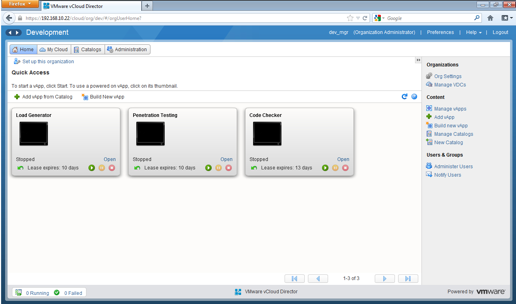Confused about the difference between vCenter and vCloud Director? You're not alone. Sure, if you are a vSphere admin at a large enterprise you already know what vCloud Director is and are likely either evaluating it or have implemented it. However, there are many IT pros out there who work at small businesses who are still trying to understand why they need virtualization or, if they are already using vSphere, why they need vCenter. There are many other IT pros at medium-sized companies who already use vCenter but don't really understand what vCloud Director is or why they need it on top of vCenter.
Comparing vCenter and vCloud Director
Being a visual person, VMware's cloud infrastructure solution diagram best shows me where vCenter fits in in reference to vCloud Director.
Figure 1 – vCloud Director Solution Diagram
As the diagram shows, vCenter is what manages your vSphere virtual infrastructure hosts, virtual machines, and virtual resources (CPU, memory, storage, and network).
As you can see from the diagram, vCloud Director is at a higher level in the cloud infrastructure. vCloud Director (vCD) can traverse multiple virtual infrastructures and further abstracts the virtual infrastructure resources into software-defined storage, networking, security, and availability.
Users of vCD don't have to know about vSphere or vCenter. They don't have to know about hosts, clusters, or resource pools. They don't have to worry about what other VMs are on their host or if there are cluster resources available to run their VMs. Finally, they don't have to worry about whether their VMs are secure or if they will be available. All of these things are abstracted away by vCloud Director such that all the vCD user needs to worry about is their organization's virtual datacenter.
Instead of managing a virtual data center in vCenter (comprised of clusters, resource pools, hosts, and VMs), vCD users manage vCD organizations, made up of organization virtual datacenters, org users, org policies, and org catalogs.
The View From vCenter
To make this comparison another way, look at the typical administrator screen used by an admin in vCenter.
Figure 2 – vCenter Admin View
From this view, you can see virtual data centers (not to be confused with organizational datacenters in vCloud), clusters, hosts, virtual machines, and vApps. However, vCloud Director doesn't know about any of these things until you tell it. Even then, it won't go deeply into monitoring and managing these types of objects (as that's not its job).
The View From vCloud Director
The other side of this proverbial "coin" is vCloud Director. Here's what it looks like from the perspective of the typical vCD organization admin:
Figure 3 – vCloud Director Organization Admin View
From this view, the vCD user (not admin, in this case) sees their vApps, organization catalogs, users, and the option to manage their virtual data center.
The vCD admin, on the other hand, has a much larger view, but still from a very different perspective than the vCenter admin:

As you can see, the vCD admin sees multiple organizations but then can control the cloud resources, including cells, provider vDCs, and networks. Additionally, vCD admins can see vSphere resources, such as vCenter servers, resources pools, hosts, datastores, and port groups but cannot view or administer those vSphere resources at the level required (and offered by vCenter).
vCenter vs. vCloud Director – Summary
In the end, what you need to know is that vCenter is required to administer your virtual infrastructure but it doesn't create a cloud. The first piece required to create your cloud is vCloud Director. vCD will talk to your vCenter server/servers but certain tasks will have to be done first in vCenter, such as creating a HA/DRS cluster, configuring the distributed virtual switch, adding hosts, etc. Bottom line: to create a cloud you'll need both vCenter and vCD. Do all companies need vCD? That's a question for another blog post.
In my opinion, the best way to learn about any tool is to try it! Download the vCloud Suite (including vSphere 5.1, vCenter 5.1, and vCloud Director 5.1) for 60 days at no cost.
For future updates, be sure to follow @vCloud and @VMwareSP on Twitter!
David Davis is a VMware Evangelist and vSphere Video Training Author for Train Signal. He has achieved CCIE, VCP,CISSP, and vExpert level status over his 15+ years in the IT industry. David has authored hundreds of articles on the Internet and nine different video training courses for TrainSignal.com including the popular vSphere 5 and vCloud Director video training courses. Learn more about David at his blog or on Twitter and check out a sample of his VMware vSphere video training course from TrainSignal.com.
Sent from my iPad



No comments:
Post a Comment